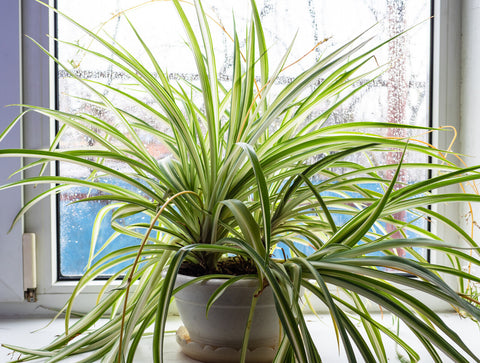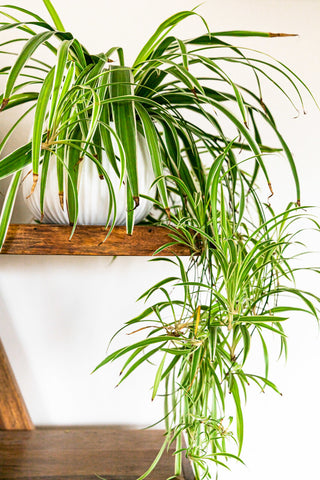The variegated leaves on the Spider Plant can brighten any shaded room. It's a great choice over artificial plants for nervous first-time plant owners: it’s easy to grow, thrives in almost any condition, and tolerates neglect! It grows very well with artificial light, so it’s perfect as a natural element in office spaces. As a bonus, the Spider Plant does double duty by cleaning the air and absorbing chemicals like formaldehyde and carbon monoxide.
Care
While the Spider Plant tolerates neglect, it will thrive as a beautiful plant with proper care.
Location
Spider Plants can grow outside in zones 10 and 11 in the ground or containers. Most will choose to keep the plant indoors. Naturally, the more you mimic its native climate, the more your Spider Plant will flourish.
The Spider Plant is a fast-growing plant with a bushy, weeping nature, so don't shove the container in a corner where the wall could crush its leaves. Instead, display your Spider Plant on a stand or push it out from any surface a good eight inches or more.
Spider plants prefer temperatures between 55 and 80°F; any colder will damage this lovely plant.
Lighting
Choose a spot with six hours of bright, indirect sunlight. Bright, indirect light means the area will be bright and illuminated without directly viewing the sun. A few feet away from a south-facing window is ideal. The Spider Plant can tolerate lower light levels but will grow slower, and the leaves might droop and become sparse. If there is too much light, you will see the bleaching of leaves.
Watering
The secret to the Spider Plant’s ability to survive neglect is in its roots. The tuber roots hold water and make it drought-resistant. How this translates into your home is to avoid over-watering and water less frequently than you would your other house plants. Spider plants like to dry out a bit between waterings.
Always check that your plants need watering before you water them. You can use your finger to feel the soil a few inches down or use a moisture meter to better understand if you should water or hold off for a few more days. There is no need to mist the leaves as the Spider Plant does well with the average humidity inside the home.
Soil
Most possible issues you might face can be avoided by investing in a high-quality soil mix. A good, well-draining potting soil works well for the Spider Plant. The texture of the soil should still be crumbly when wet.
Fertilizing
The Spider Plant doesn’t need much fertilizing as its tubers store nutrients besides water. Fertilize up to twice a month in the spring and summer. Always read the product labels and instructions to determine the dosage and frequency of application. The Spider Plant doesn’t need fertilizing during the winter.
Container
The Spider Plant is a very easy going plant that can do well in a variety of containers. The material of the container is up to you, but do make sure that the container you choose has drainage holes. Spider Plants can grow quite fast, so check yearly to see if the roots are circling around the container or growing out of the drainage holes; this is the best way to know when it's time to repot. When it’s time to repot, choose a container that is around 2 inches larger in diameter than the previous one and just as deep.

Troubleshooting
Spider Plants are tough when it comes to pests, but they can be susceptible to some pest infestations. Plants are susceptible to root rot if waterlogged, as well as the invasion of whiteflies, spider mites, scales, and aphids. Treat with Neem Oil or a horticultural oil if you discover pests on your plant. It is also a good idea to move your plant away from others during this time to avoid the spread.
Other issues you might encounter are with the leaves. Use this chart to narrow down your issue and how to fix it!
|
Issue |
How to Fix |
|
Crispy leaf tips turning brown and falling off. |
This is a sign that the water in the plant is off. Try increasing the humidity in the area with a humidifier and checking to see if the roots are healthy and uptaking water. |
|
Pale leaves or leaves that look bleached in color. |
The lighting needs to be fixed. It is likely the case that your plant is receiving too much or too little light. Adjust the location and see if the color returns on newer growth. |
|
Drooping leaves |
This is likely caused by over or under watering. To fix this issue, feel your soil for moisture levels and water if needed. Continue to monitor your plant and it should perk up in no time. Set a reminder to water the plant to prevent it happening in the future. |
Pruning
Spider plants need very little pruning. Feel free to trim off any off growth that needs to be cut back. As with any plant, remove any damaged, broken, or diseased leaves at any time.
Feel free to propagate your plant too! Do this by snipping off one of the “babies” or offshoot growth of the main Spider Plant and set it in shallow water. Refresh the water every other day, and in around a week you should start to see root growth! When you have around one inch of roots, plant your new Spider Plant in a small container.
Suggested Uses
A Spider Plant can add an attractive spot of green that won’t dominate the visuals of a room. Hanging baskets are the traditional way to showcase the Spider Plant, letting the offshoots cascade over the sides. Displaying your Spider Plant by hanging or even placing it on a shelf draws the eye upwards in the space. Get creative where and how you display your Spider Plant to best match your personal style. Consider pairing your Spider plant with something like a Coffee Plant with dark green leaves and a compact shape for contrast. Then you may want to add a more rare plant, such as the Crocodile Fern or Ficus Ruby Rubber Plant. Spider Plants can be used as an annual (lasting one year then dying off), similar to Liriope, in plant beds, or as edging in cooler climates.
Native Range
Spider plants grow natively near the west coast of Africa in north Namibia. This roughly translates to growing zones 9 and 11. Instead of hanging baskets or in containers, they grow in clumps on the forest floor, shielded from direct sun by bushes and trees. They are known to be remarkably hardy and are excellent as house plants for this reason, even thriving in office environments.

History
Around the time the American Colonists were considering a revolution, a Swedish naturalist, Carl Thunberg, was on a botanical exploration in southern Africa and first described the Spider Plant. It became popular during the Victorian period when the Upper Crust decorated their parlor with ornamental plants like ferns, and you guessed it, Spider Plants! It gets its common name from the spidery appearance of the small plantlets produced on long trailing stems as it grows. .
Enjoy the Spider Plant and how it brightens up your space. As always, if you have any concerns or questions please reach out to our plant experts and we will be happy to assist.


